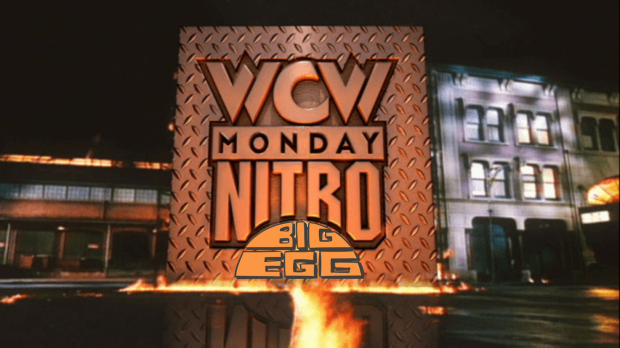Meiko Satomura Defeats Akira Hokuto in One of Wrestling's Most Triumphant Moments
Meiko Satomura and Akira Hokuto affirm their greatness in an absolute stunner of a wrestling match.
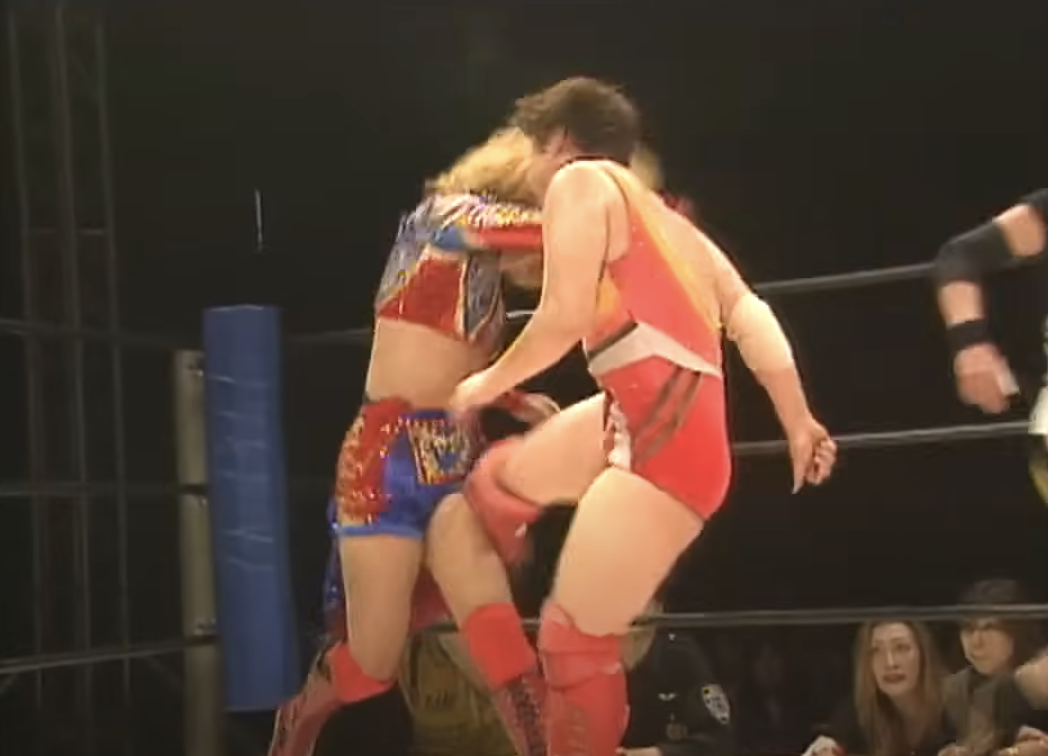
You can tell how this one will end within a split second of the opening bell. Meiko Satomura has her arm extended for a pre-match handshake, a show of respect, and Akira Hokuto, the Dangerous Queen, considers it, hands on hips. Satomura insists upon the handshake, and Hokuto takes it, immediately goes to pull her in for a slap, which connects, but nowhere near as hard as her well-prepared opponent’s. The crack of Satomura’s hand across Hokuto’s cheek echoes through the arena, and while Hokuto is able to recover, she is decidedly on her back foot. This will not be her night.
There isn’t a single iteration of the handshake spot in professional wrestling that isn’t a cliche at this point, but here’s one you don’t see very often, where the heel attempts to take advantage of the babyface’s good intentions and ends up embarrassed. Usually it’s the babyface taking the strike, fighting out from underneath the unexpected blow and the resulting disrespect, a tried and true narrative stroke, but here we’re playing at something different. It is 2001, seven years into Meiko Satomura’s career, and she is on the doorstep of winning the AAAW Title, some distance from the girl Hokuto first encountered at the Disney-MGM Studio during a WCW Worldwide taping, a few days removed from her 17th birthday.
Speaking of WCW, next week I'll be launching a new feature at BIG EGG: The WCW Monday Nitro Masterlist. It will be available to paid subscribers at the $2 and $7 a month levels. If you're seeing this, you are neither and have more rocks in your head than Bobby the Stain.
With the show hitting its 30th anniversary this year, there's no time like now to launch an endless project about it, and "reviewing every WCW Monday Nitro match and ranking them from worst to first" certainly qualifies. Join me next Monday at the Mall of America by hitting the button below!
This Meiko Satomura is a worldbeater, and Akira Hokuto, one of the major figures of All Japan Women’s Pro Wrestling’s 1990s peak, is the world that’s about to get beat. She doesn’t make it easy, though. She takes a lot of shots to her legs, but manages to avoid Satomura’s attempt at an early killshot, which breaks Satomura’s stride enough for Hokuto to catch another kick and land the sort of palm strike that’d cause a lesser woman to quit the business. A second sends Satomura reeling into the corner, but now it’s Hokuto’s turn to press the advantage, which she does by landing a Death Valley Driver, which she immediately turns into an early attempt at Strangle Hold Gamma. It doesn’t take, but Hokuto can see that before Satomura can really get her wits about her, so she resorts to option B: driving her knee into Satomura’s skull.
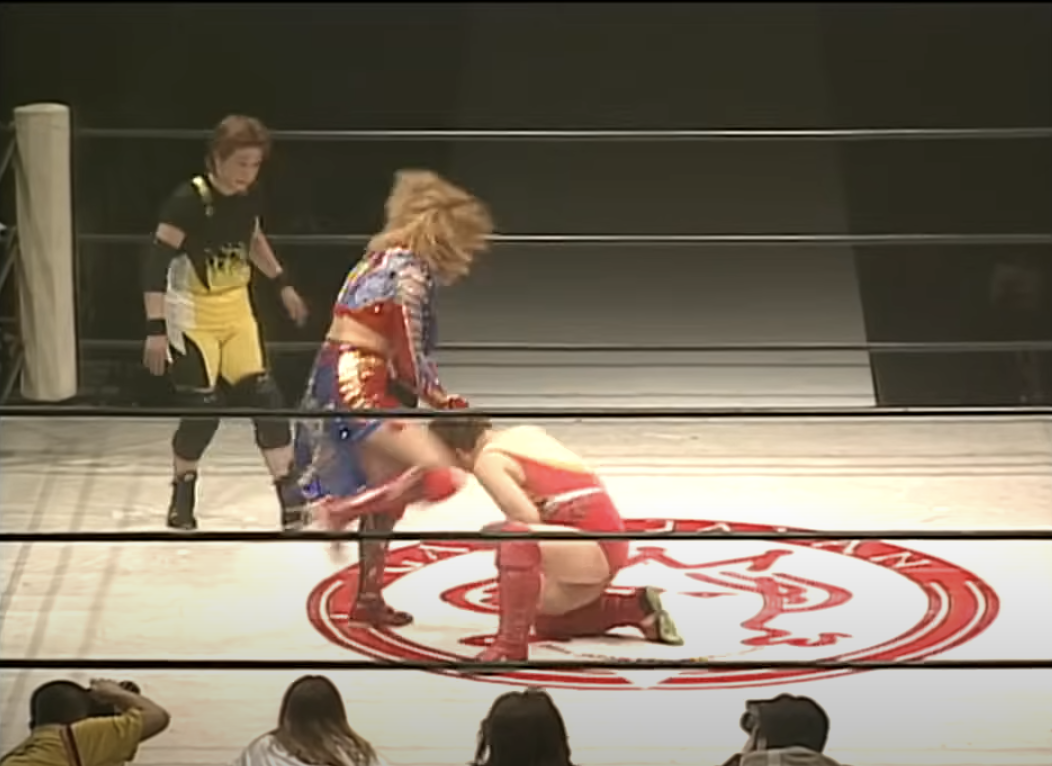
All of the above, an entire universe of physical poetry, takes place in about 90 seconds. With the world seemingly set back in order at the point of Hokuto’s knee, the next 20 minutes will be spent working back to this early emotional peak, the frenzied, hyperkinetic feeling of witnessing a new era declaring its arrival at the expense of the old. This does not come easily, as Hokuto has already found, in her open-hand palm strike, a weapon that can stop Satomura dead in her tracks. The third one, which Hokuto lands after using the momentum of an Irish whip against Satomura, sends the younger wrestler to the mat clutching her ear. From there, she’s feral with them, yanking Meiko Satomura up from the mat by her arm to slap her back down, Satomura ragdolling to the canvas each time. It’s an effective strike and a potent metaphor — the Dangerous Queen slapping down a usurper, a veteran disrespecting someone she considers her junior.
It also shifts Meiko Satomura’s focus. Whatever her strategy was at the opening bell, she can’t expect to win this if she keeps taking knockout blows to the head without a response … so she responds. Jolted out of a concussive haze by Hokuto, she dead stops at the end of another attempt at a short-arm palm strike to land the Pele kick Hokuto had earlier been able to block, immediately followed up by kicks to the front and back of the head. If she’s to win the match, it won’t be by finesse, precision, or skill — it’ll be, to steal a rival promotion’s phrase, a victory through guts, one taken from Hokuto over her dead body. This isn’t about wrestling moves, pinfalls, or tapping out, as she immediately learns when Hokuto has enough after this assault to shift her weight and counter Satomura’s DVD into an armbreaker, but heart.
This is the kind of struggle that joshi truly excels in telling the tale of, perhaps more than any other form of professional wrestling. These early moments of the match, from the handshake to now, set the table magnificently. You’re shown what Satomura wants from Hokuto (her respect), what Hokuto thinks of Satomura (not much), and that the two are equals, the conflict between them becoming even more highly charged as both women are going to have to go to extremes to prove the other wrong.
This is, again, not an altogether uncommon story in professional wrestling. Today it’s pretty common, as wrestlers throw down the gauntlet over concepts like “best wrestler in the world.” Last week I reviewed a recent example of this conflict, Bryan Danielson vs. Will Ospreay from AEW Revolution 2024, which is in some ways a faint echo of this match — it’s a friendlier version of the experience gap dynamic between Hokuto and Satomura whose structure, where the two figure out that they’re much closer to each other than it seems and build to a “first man to land their death blow wins” finish, is bloated (perhaps necessarily) by AEW’s success in creating an aura around the match. What I like most about this kind of story is when that realization sets in and all pretense of wrestling as honorable or beautiful is dropped — when these bastards start to scrap. In Danielson/Ospreay, those moments were fleeting, bits between the larger moments that had fans who weren’t me in the palm of their hand.
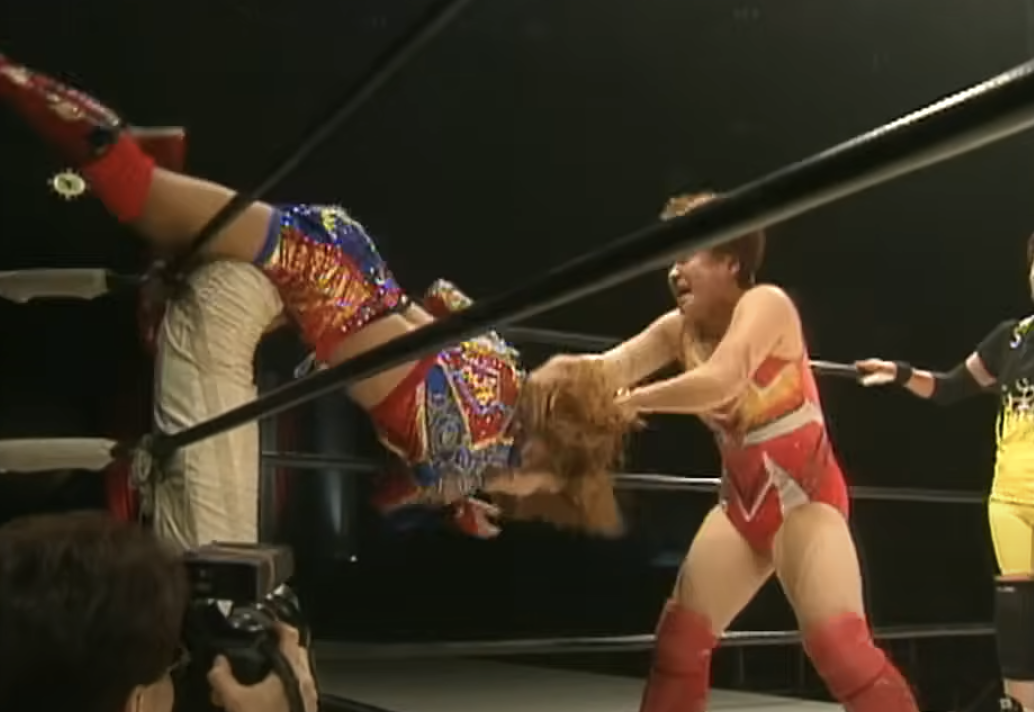
Here, it’s all scrap, and it only escalates as both Hokuto and Satomura realize that there’s more on the line here than a win. When the two of them start pulling each other down from the top rope by the hair, trying to beat each other to be the first to land something off the top rope? That’s pro wrestling, the fury and hubris of it, the way you can lose yourself in the idea of hurting your opponent until they’re kicking you in the back of the head as a reminder that you are, in fact, just as frail and breakable as they. Or where you’ve got your opponent on her back and down for the count, but it’s not enough so you go for that one extra thing and end up tied in knots for your trouble.
In a match like this, there is no such thing as momentum, just opportunity, and two very different ones open themselves up here. For Akira Hokuto, it’s Meiko Satomura’s arm, already taped up and now the focus of an onslaught that’s included multiple submission holds and mean short-arm wrenches and Irish whips. For Satomura, it’s the knockout. After watching this match the first time, where the finish caught me unawares, I wondered if the story of this match was that Hokuto had made a mistake in targeting a limb instead of the head, especially as her palm strikes had been so effective, but that’s less and less true the more Satomura chips away at her, continuing to kick at her leg, taking away a lot of her power. Satomura is able to endure Hokuto’s palm strikes in a slap exchange, and when they go to the mat it’s Hokuto who has a clear advantage.
Her mistake, if you can call it that, is thinking that she can put Meiko Satomura down conventionally, for giving her three seconds to kick out, a gasp of breath she can use to reach out for the ropes on a Strangle Hold Gamma attempt. Every time she challenges Satomura to get up or solve a puzzle, she does, and while their war is very much one of attrition, by the time she ends up in her own family submission hold, she’s giving up weapons to an increasingly hungry foe. She realizes this, I think, when Satomura kicks out of a backdrop suplex despite being dumped on her neck and head, pounding the mat in frustration to contest the count. A second one doesn’t put her down, either, nor does a rolling kick that she puts some extra oomph into the pinfall for, which prompts a bridge out.
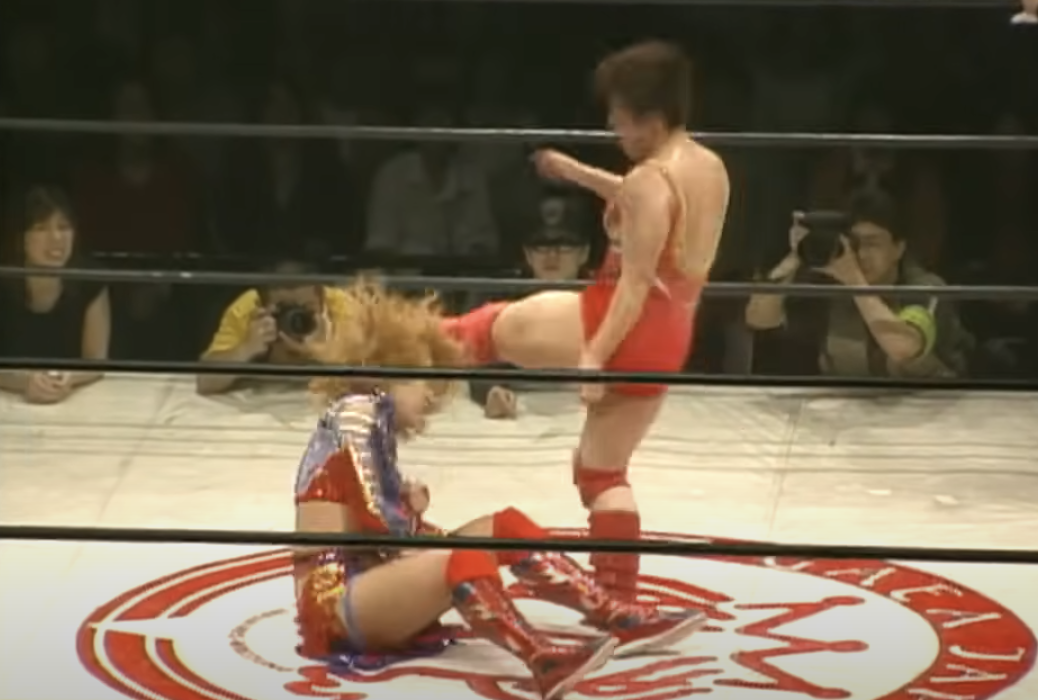
By the time she figures out Satomura’s game, she is on her back, the referee checking her head because she just got kicked square in the fucking face while Meiko waits things out. If this is it, if Hokuto can’t continue, she has what she wants. If she gets up, she does so having given Satomura time to recover. Hokuto has now had to change her endgame three times, while Satomura has been working towards this conclusion since the moment she was first put on her ass by a palm strike. There’s more to go, but Hokuto is punched out at this point, lucky to avoid another Pele, desperate when she throws and lands a palm strike. After eating a series of them and getting up like the Terminator after each blow, Satomura kicks out at one on one of wrestling’s most desperate pin attempts, turns around, and kicks Hokuto right in the face.
Like the Kong/Ozaki vs. Satomura/Kato tag match, what makes this match so special is not just the moment at which it reveals the babyface’s triumph, but the amount of time it gives you to revel in it. Once the facade of the big bad cracks, they are essentially at the mercy of our hero. If you’re mostly familiar with American wrestling, this is somewhat at odds with the usual means of babyface triumph, particularly this era, which is a hybridization of the super indie/2010s NJPW style and the late-90s boom period’s emphasis on finishers, where a wrestler gets their ass beat, hits their finish, wins, and the moment of elation is spent watching them celebrate to their theme song. Here, the thrill is in knowing for at least 10 minutes that Akira Hokuto, one of the greatest wrestlers in history, simply cannot beat Meiko Satomura. In watching the Dangerous Queen grow increasingly desperate as that realization dawns on her, digging her grave deeper by resorting to headbutts against someone who has been kicking her head in for 15 minutes or going for a flipping senton to the floor and missing.
It’s almost paradoxical that these closing moments, when Meiko Satomura is spamming DVDs and head kicks and locking Hokuto in the Strangle Hold Gamma, reaffirm Akira Hokuto’s aura. But here, backed into a corner, she refuses, as Satomura did all match long, to die. In three minutes, she goes through the entire arc she put Satomura through, struggling to the ropes while running out of air, getting kicked in the head, bridging out of a pinfall attempt. Where the babyfaces had previously comforted Meiko, it’s heels like Police and Mayumi Ozaki (a fucking legend, a goddamn queen when she tries to break up the submission and is pulled back by her friends) trying to rally Hokuto. Calling back to the moment the bell rang, both women strike each other at the same time, and both pay the price, Hokuto clutching her leg after a kick, Satomura’s head ringing from a slap.
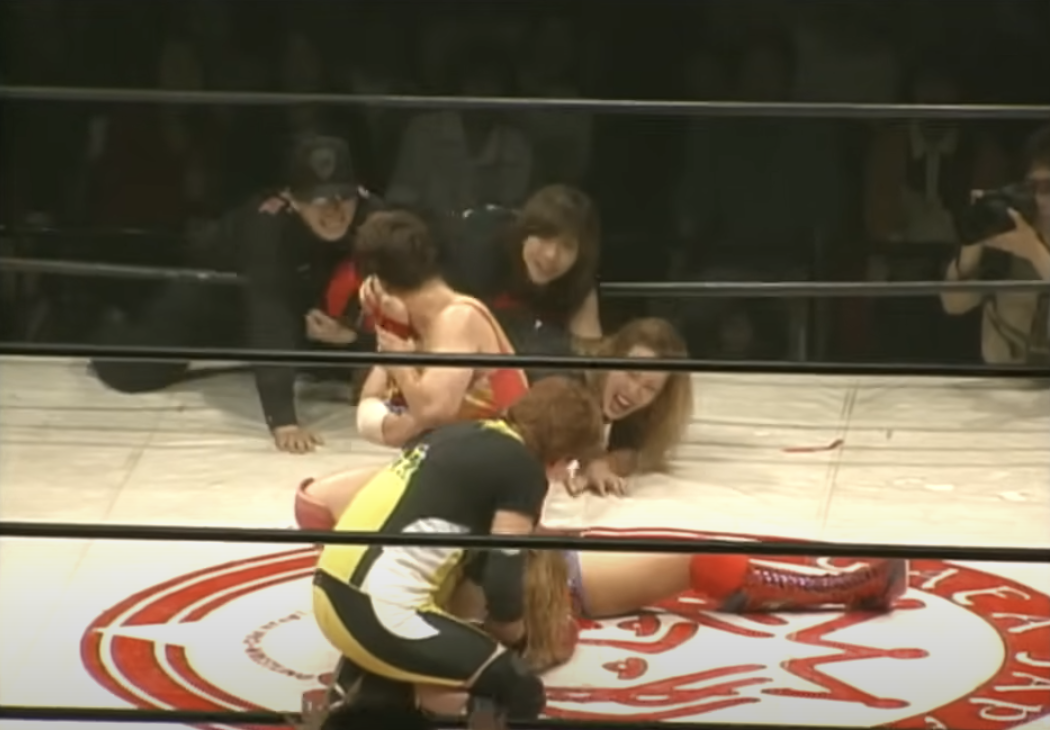
The last such exchange is magnificent stuff, Satomura falling to her back, Hokuto managing to stay on her feet long enough to seize the advantage and go for the pin. I’m not sure what to call this — it’s not a false finish, Satomura’s not losing to this palm strike, but it is a massive headfake, a moment where it seems like Hokuto has finally found her opportunity to end it, only Satomura’s persistence with the leg kick saves her — first from taking a Northern Lights Bomb, then from Hokuto having much control when she does manage it, which leads to Satomura’s leg crushing her face. Recognizing that the two wrestlers have reached a point of no return, the referee starts a 10 count, and while both have the guts to respond, Akira Hokuto’s leg gives out, she collapses into the ropes, and Meiko Satomura roars in triumph.
Coincidentally, that’s what this match is. A triumph. I’ve gushed a lot about the finishes of the matches Joseph picked for GAEA month, but this is the one I didn’t immediately freak out for on stream, probably because I didn’t realize it was on the table. It is, I think, the best of the bunch though. There is no wasted time signalling, no obvious red herrings, no suspension of logic — two women spend 20 minutes hitting each other in the head as hard as they can, then end up getting hit in the head simultaneously. That it’s Hokuto who is undone by her own finisher by the burgeoning ace of the next generation is the kind of bittersweet note only pro wrestling is capable of, and even then very rarely. Bret Hart beat “Stone Cold” Steve Austin with the Sharpshooter but lost his grip on the World Wrestling Federation in one of the greatest matches of all time. Here’s another match that belongs at that peak.
Rating: *****

